When facing issues with your John Deere 4100, knowing the top solutions can save you time and frustration. From addressing engine starting problems to troubleshooting hydraulic system leaks, each solution plays an important role in keeping your equipment running smoothly. By following these expert tips, you can enhance the performance and longevity of your John Deere 4100.
Things to Note
- Check battery connections and fuel levels for proper operation.
- Inspect wiring harness and electrical components for wear.
- Use fuel additives and inspect fuel lines to prevent issues.
- Regularly clean the radiator and monitor coolant levels.
- Address transmission fluid levels and PTO system maintenance promptly.
Engine Starting Issues
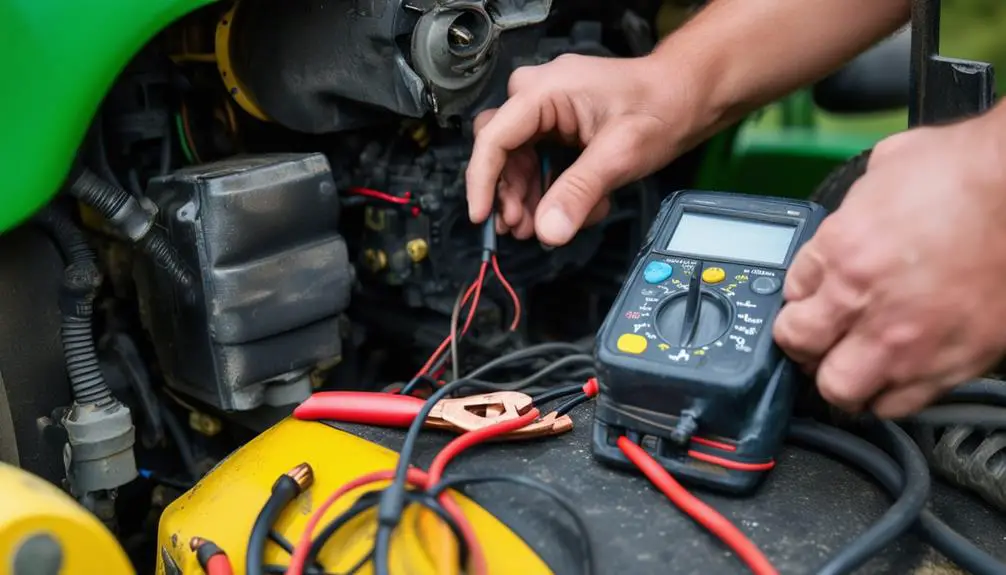
If you're experiencing trouble starting your John Deere 4100 engine, begin by checking the battery connections and fuel levels. Make sure the battery terminals are clean and tightly connected. Freeing yourself from starting issues can often be as simple as ensuring a solid power supply to kickstart your engine. Additionally, confirm that there's enough fuel in the tank. Sometimes the solution lies in the most basic of checks, setting you free from the frustration of a non-starting engine.
Another area to explore when tackling engine starting problems is the air filter. A clogged air filter can restrict airflow, hindering the combustion process. By freeing your air filter from dirt and debris, you allow the engine to breathe freely and operate smoothly.
In your quest for engine liberation, remember to also inspect the spark plugs. These small yet essential components ignite the fuel-air mixture in the engine cylinders. By replacing worn-out spark plugs, you empower your engine to start efficiently, freeing you from the inconvenience of starting troubles.
Electrical System Troubleshooting
When troubleshooting the electrical system on your John Deere 4100, start by inspecting the wiring harness for any signs of damage or wear.
Next, test the battery voltage to make sure it's within the proper range for peak performance.
These steps can help pinpoint and resolve any electrical issues affecting your equipment's operation.
Wiring Harness Inspection
Inspect the wiring harness carefully for any signs of damage or wear to troubleshoot electrical issues in your John Deere 4100. Start by visually examining the entire length of the wiring harness, looking for any fraying, cuts, or exposed wires. Check for melted insulation or any discoloration that could indicate overheating. Verify all connections are secure and free of corrosion.
Give special attention to areas where the harness may rub against sharp edges or moving parts, as these are more prone to damage.
If you spot any issues during your inspection, such as damaged wires or connectors, take immediate action to repair or replace the affected parts. Ignoring wiring harness problems can lead to electrical malfunctions that may affect the performance of your John Deere 4100.
Battery Voltage Testing
Consider testing the battery voltage as part of your electrical system troubleshooting process for your John Deere 4100. Checking the battery voltage can give you valuable insights into the health of your electrical system and help pinpoint issues that may be affecting your tractor's performance. Here is a simple table to guide you through the battery voltage testing process:
| Battery Voltage | Interpretation | Action |
|---|---|---|
| Below 12.4V | Low voltage, may indicate a weak battery | Recharge or replace the battery |
| 12.4V – 12.6V | Normal voltage range | Continue monitoring |
| Above 12.6V | High voltage, could be due to overcharging | Check the charging system |
Fuel System Maintenance
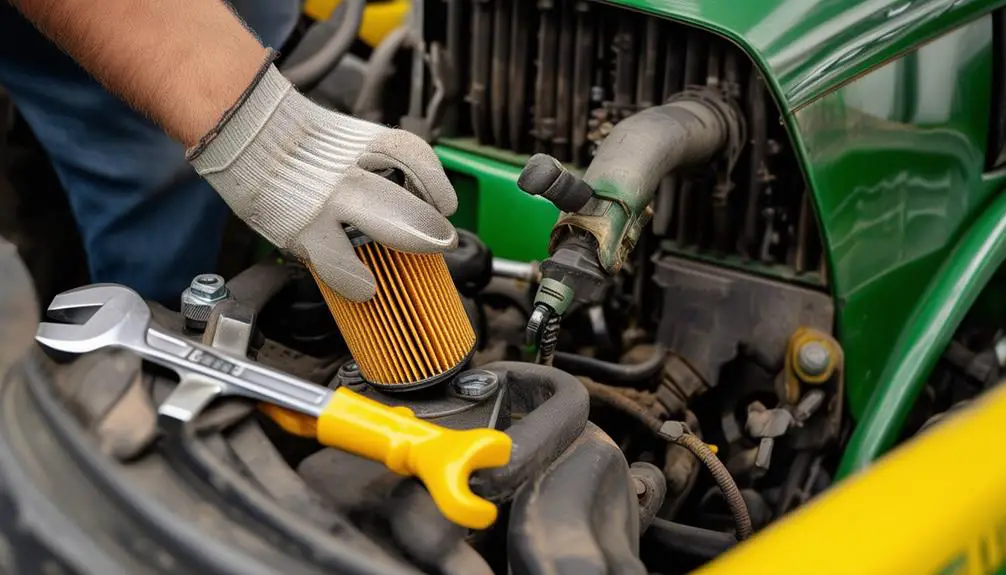
To maximize performance of your John Deere 4100, regularly clean and inspect the fuel system components. Keeping your fuel system in top condition guarantees that your tractor runs smoothly and efficiently.
Here are some essential tips for maintaining your John Deere 4100's fuel system:
- Use Fuel Additives: Additives can help clean deposits from the fuel system, enhancing fuel efficiency and engine performance.
- Inspect Fuel Lines: Regularly check for any signs of leaks, cracks, or damage in the fuel lines. Addressing these issues promptly can prevent more significant problems down the line.
- Replace Fuel Filters: Change the fuel filters at recommended intervals to prevent clogs and ensure clean fuel reaches the engine. Clogged filters can lead to engine stalling and reduced performance.
Cooling System Solutions
If you're experiencing cooling issues with your John Deere 4100, consider starting with some basic maintenance tasks.
Begin by cleaning the radiator to guarantee proper heat dissipation.
Additionally, keep an eye on your coolant levels and consider replacing the thermostat if necessary.
Radiator Cleaning Tips
Maintain regular upkeep by cleaning the radiator of your John Deere 4100 to prevent overheating issues. Dust and debris can easily accumulate on the radiator fins, hindering proper airflow and causing the engine to overheat.
Here are three simple tips to help you keep your radiator clean and your tractor running smoothly:
- Regular Inspection: Make it a habit to visually inspect the radiator regularly for any buildup of dirt, bugs, or debris. By catching these issues early, you can prevent them from causing more significant problems down the line.
- Gentle Cleaning: When cleaning the radiator, use a soft brush or low-pressure air to gently remove any obstructions. Avoid using high-pressure water or harsh chemicals, as these can damage the delicate fins of the radiator.
- Check Coolant Levels: While cleaning the radiator, take a moment to check the coolant levels. Proper coolant levels are essential for maintaining the engine's temperature and preventing overheating.
Thermostat Replacement Advice
Regularly replacing your thermostat can help maintain the best cooling system performance in your John Deere 4100. A thermostat that is not functioning correctly can lead to overheating or inefficient cooling, causing potential damage to your tractor's engine. To ensure peak performance, consider the following advice when replacing your thermostat:
| Thermostat Replacement Advice | Description | Benefit |
|---|---|---|
| Choose a Quality Thermostat | Opt for a durable thermostat from a reputable brand | Ensures durability and reliability |
| Follow Manufacturer Guidelines | Adhere to John Deere's specifications for thermostat replacement | Prevents compatibility issues |
| Check Coolant Levels | Verify coolant levels are adequate after thermostat replacement | Maintains proper cooling efficiency |
Coolant Level Monitoring
Keep track of your coolant levels consistently to ensure the best performance of your John Deere 4100's cooling system. Monitoring your coolant levels is essential for preventing overheating issues and maintaining peak engine functionality.
Here are some tips to help you effectively monitor your coolant levels:
- Regular Checks: Make it a habit to check your coolant levels regularly, especially before long trips or heavy use.
- Use the Proper Coolant: Confirm you're using the correct type of coolant recommended for your John Deere 4100 to avoid any compatibility issues.
- Inspect for Leaks: Keep an eye out for any signs of leaks in the coolant system, such as puddles under the vehicle or visible drips, and address them promptly to prevent coolant loss.
Transmission Problems Resolved
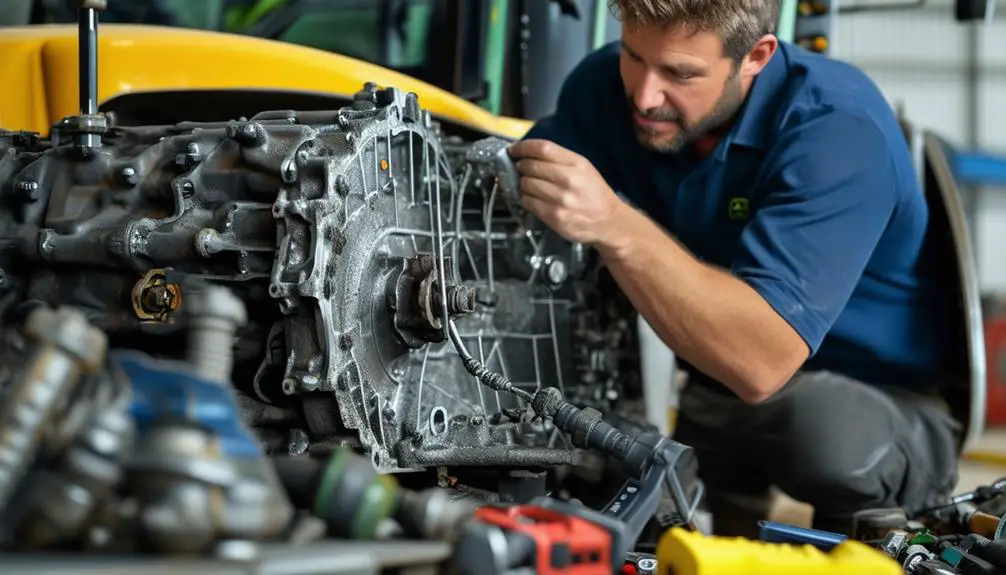
If your John Deere 4100 is experiencing transmission problems, addressing them promptly can prevent further damage. One common issue is rough shifting or gears slipping, which can be frustrating. A practical step to resolve this is to check the transmission fluid level first. Low fluid levels can cause these problems, so ensuring it's at the correct level is essential.
If the fluid is fine, the next step is to inspect for any leaks or damage to the transmission system. Leaks can lead to low fluid levels and affect the transmission's performance. Tightening loose bolts or replacing damaged seals can often fix these issues.
Another possible cause of transmission problems is a faulty transmission filter. If you notice issues with shifting gears smoothly, consider replacing the filter. It's a relatively simple fix that can greatly improve performance. Additionally, ensuring that the transmission system is properly lubricated can also prevent problems.
Regular maintenance and fluid checks are key to keeping your John Deere 4100's transmission running smoothly. Addressing transmission issues promptly can save you time and money in the long run.
PTO System Fixes
To address issues with your John Deere 4100's PTO system, start by checking for common problems that could affect its performance. Here are some straightforward fixes to get your PTO system up and running smoothly:
- Inspect the PTO Clutch:
Confirm the PTO clutch isn't worn out or damaged. Replace it if necessary to restore proper functionality.
- Check for Loose Connections:
Examine all electrical connections related to the PTO system. Tighten any loose connections to guarantee a secure and reliable electrical flow.
- Verify Proper Lubrication:
Lack of lubrication can cause the PTO system to malfunction. Make sure all components are adequately lubricated to prevent friction and enhance performance.
Hydraulic System Troubleshooting
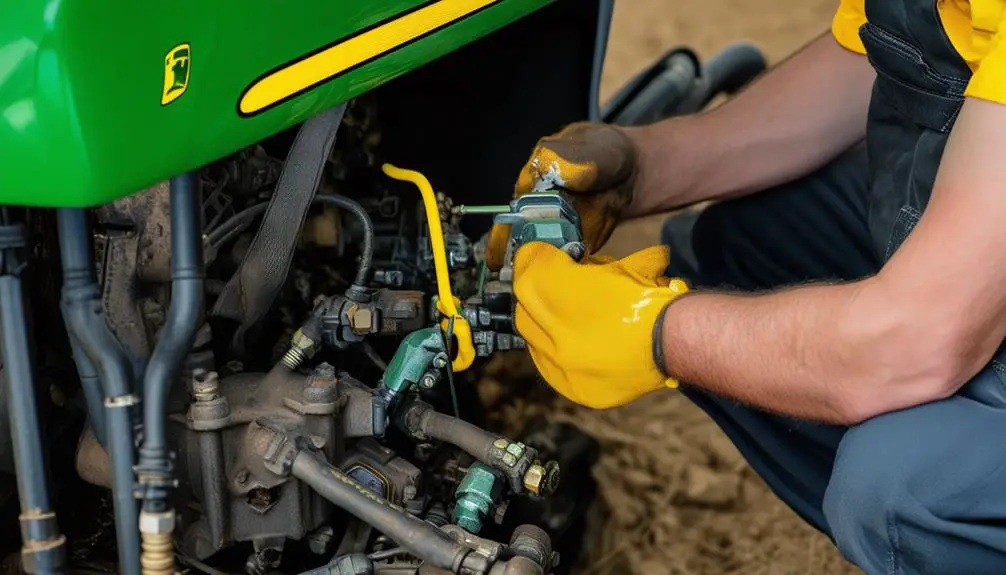
If you notice any fluid leaks on your John Deere 4100, it's vital to address them promptly to prevent further damage.
Understanding how to troubleshoot pump issues can help you keep your hydraulic system running smoothly.
Let's explore common signs of fluid leaks and some troubleshooting tips for pump problems.
Fluid Leaks: Common Signs
Fluid leaks in your John Deere 4100 are often indicated by visible puddles or stains underneath the machine. If you notice any of these signs, it's essential to address the issue promptly to prevent further damage.
Here are some common signs of fluid leaks to look out for:
- Unusual Odors: If you detect strange smells like burnt oil or hydraulic fluid, it could be a sign of a leak in the hydraulic system.
- Low Fluid Levels: Regularly check the fluid levels in your John Deere 4100. A sudden drop in fluid levels without any visible leaks could indicate an internal leak.
- Loss of Hydraulic Power: If you experience a decrease in hydraulic power or responsiveness, it could be due to a fluid leak affecting the system's performance.
Pump Issues: Troubleshooting Tips
Addressing pump issues in your John Deere 4100 hydraulic system requires thorough troubleshooting to identify and resolve potential problems efficiently. When dealing with pump problems, start by checking for any visible leaks, unusual noises, or issues with the implement response. Here are some troubleshooting tips to help you tackle pump issues effectively:
| Symptom | Possible Cause | Solution |
|---|---|---|
| Visible fluid leaks | Damaged seals or hoses | Inspect and replace any damaged components |
| Whining noise | Low fluid levels | Check and refill hydraulic fluid to the proper level |
| Poor implement response | Clogged filters | Replace filters and clean the hydraulic system |
| Overheating | Excessive load or dirty fluid | Reduce load and flush the system with clean fluid |
Steering System Adjustments
To improve the steering system on your John Deere 4100, consider adjusting the wheel alignment for best performance. Proper wheel alignment guarantees your tractor moves straight and responds accurately to your steering inputs.
Here are three quick adjustments you can make to enhance your steering system:
- Check Tire Pressure: Confirm that the tires are inflated to the recommended pressure levels. Low tire pressure can cause uneven wear and affect steering responsiveness.
- Inspect Tie Rod Ends: Examine the tie rod ends for any signs of wear or damage. Worn-out tie rod ends can lead to steering issues and should be replaced promptly.
- Lubricate Steering Components: Regularly lubricate the steering components to reduce friction and guarantee smooth operation. Greasing the steering system helps maintain its functionality over time.
Brake System Repairs
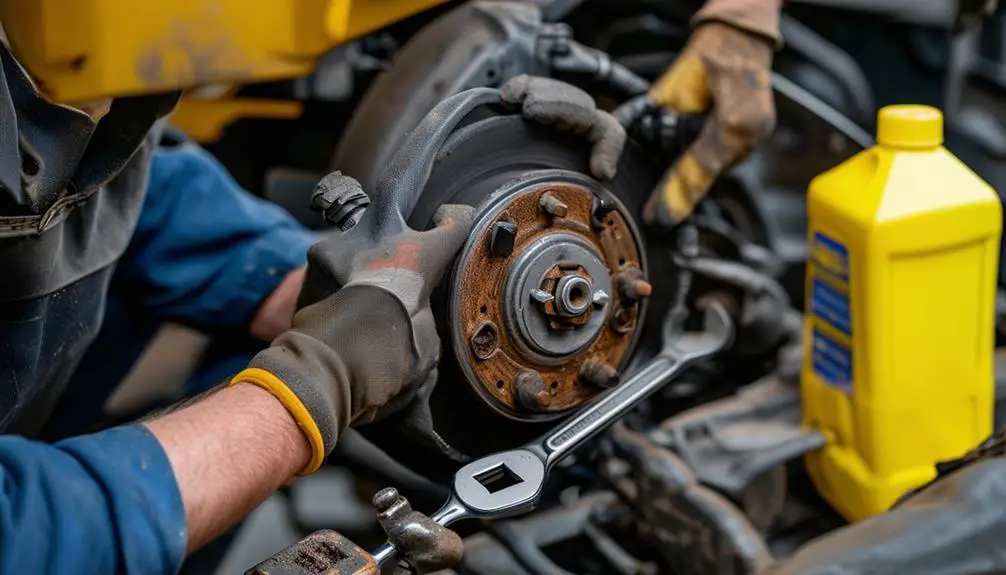
Examine your John Deere 4100's brake system regularly to guarantee excellent performance and safety. Your safety on the field depends on reliable brakes.
If you notice any squeaking, grinding, or reduced responsiveness when you press the brake pedal, it's time to take action. Start by checking the brake fluid level and ensuring there are no leaks in the system. If the fluid is low, fill it up with the manufacturer's recommended type.
Inspect the brake pads for wear and tear; replace them if they're too thin. Additionally, check the brake lines for any signs of damage or corrosion.
If you're experiencing vibrations or pulling to one side when braking, it could indicate issues with the brake rotors that need immediate attention. By addressing these brake system repairs promptly, you'll maintain peak braking performance and keep yourself safe during operation.
Regular Maintenance Tips
Regular maintenance tips play a vital role in guaranteeing the overall longevity and performance of your John Deere 4100. To keep your machine running smoothly and avoid potential issues, here are three essential maintenance tasks to follow:
- Regular Oil Changes: Changing the engine oil and filter at recommended intervals helps prevent premature wear and guarantees proper lubrication, promoting ideal engine performance.
- Air Filter Inspection: Regularly inspecting and cleaning or replacing the air filter prevents dirt and debris from entering the engine, maintaining efficient combustion and extending the engine's life.
- Tire Pressure Check: Maintaining the correct tire pressure not only ensures better traction and stability but also reduces wear and tear on the tires, promoting fuel efficiency and preventing blowouts.
Frequently Asked Questions
How Can I Improve the Overall Performance of My John Deere 4100?
To enhance your John Deere 4100's performance, start with regular maintenance. Check filters, fluids, and tire pressure.
Consider upgrading to high-quality fuel and lubricants. Keep the engine well-tuned and the blades sharp.
Also, guarantee proper storage and clean air intake. Regularly inspect and replace worn parts.
Are There Any Aftermarket Upgrades Available for the John Deere 4100?
Yes, there are aftermarket upgrades available for the John Deere 4100. These upgrades can enhance its performance and functionality.
You can explore options like upgraded exhaust systems, improved air filters, and power tuners to boost horsepower and efficiency.
Upgrading components like tires, lights, and suspension can also improve your overall experience with the John Deere 4100.
Research and choose upgrades that best suit your needs and preferences.
What Are the Common Wear and Tear Parts That Need Regular Replacement?
When it comes to your John Deere 4100, regular maintenance is key. Think of it like tending to a garden – you need to keep an eye on the common wear and tear parts.
Components like filters, belts, and fluids should be checked and replaced as needed to guarantee your machine runs smoothly.
Stay proactive and show your Deere some love, and it'll keep working hard for you.
Can I Use Alternative Fuel Types in My John Deere 4100?
You can't use alternative fuel types in your John Deere 4100. Stick with what's recommended to avoid any issues.
It's important to follow the manufacturer's guidelines for fuel to keep your machine running smoothly. Using alternative fuels could damage the engine and void your warranty.
Play it safe and save yourself from potential headaches down the road. Stick to the tried and true fuel options for your equipment's best performance.
How Do I Properly Store My John Deere 4100 During the Off-Season?
When storing your John Deere 4100 during the off-season, consider it a dormant seed waiting to bloom. Prepare it by cleaning, changing fluids, and removing the battery.
Store it in a dry, sheltered place to safeguard it from the elements. Cover it securely to prevent dust and debris from settling.
Regularly check on it to guarantee its well-being until it's time to awaken its potential once more.
Conclusion
To sum up, by implementing these top 10 solutions for John Deere 4100 problems, you can guarantee your tractor runs smoothly and efficiently. Remember, regular maintenance is key to preventing potential issues.
Just like a well-oiled machine, your John Deere 4100 will continue to operate at its best when you take care of it properly.
So, roll up your sleeves, get to work, and keep your tractor in top condition for years to come.